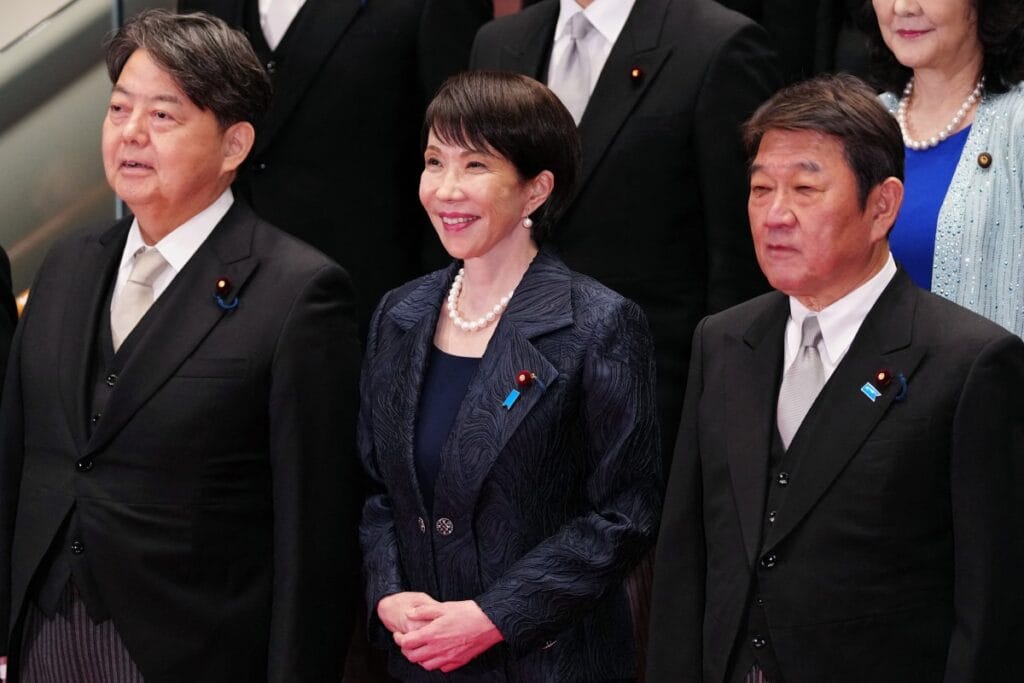October 22, 2025
SEOUL – As Sanae Takaichi became Japan’s first female prime minister on Tuesday, Seoul anticipates continuity rather than confrontation in its ties with Tokyo, according to observers in Seoul.
Takaichi takes office amid turbulent domestic politics and an increasingly fraught global security environment compounded by intensifying US-China rivalry under the second Trump administration. Yet analysts predict she is unlikely to derail the current rapprochement in South Korea-Japan relations fostered by her predecessors.
The echoes of her mentor, the late Prime Minister Shinzo Abe, and his strain of historical revisionism, however, could cast a shadow over the two neighbors’ fragile fence-mending.
Observers cautiously warn the leadership shift in Japan could reawaken tensions over wartime history and long-standing historical issues stemming from Japan’s occupation of the Korean Peninsula from 1910 to 1945.
Takaichi’s new coalition partner, the far-right Japan Innovation Party, is known for its nationalist stance on security and historical issues, including calls to delete Article 9’s pacifist clause from Japan’s postwar constitution — a development that adds another layer of uncertainty for Seoul.
President Lee Jae Myung’s administration, meanwhile, has made elevating relations with Tokyo a diplomatic priority. Japan was the first destination for both President Lee’s and Foreign Minister Cho Hyun’s first overseas trips, for instance.
The key question now is whether the momentum built under former leaders Fumio Kishida and Shigeru Ishiba — after years of rupture between Seoul and Tokyo during the Abe era — can persist under the Takaichi administration.
Analysts in Seoul expect the Takaichi administration to pursue a steady, pragmatic course with South Korea — mirroring the measured approach taken by the Lee administration and defying widespread expectations.
Lee Won-deog, professor of Japanese studies at Kookmin University, assessed that “In essence, her inauguration will have little substantive impact on South Korea-Japan relations.”
Professor Lee described Takaichi as a nationalist and hardline conservative — and, in some respects, historical revisionist rather than outright far-right — noting that she shares much of former Abe’s ideology, worldview and policy orientation.
But he noted that both domestic and international realities will inevitably constrain Takaichi’s policy options, saying, “There are clear limits to how much change she can pursue in relations with Korea.”
Lee also pointed out that “there is little incentive for her to adopt policies that might provoke South Korea or reignite tensions with Seoul.“
“From Japan’s standpoint, the situation is far from easy. Like South Korea, Japan finds itself simultaneously caught in the framework of US-China rivalry for hegemonic,” Lee said.
“Moreover, South Korea and Japan currently share a great deal of strategic interests and common benefits in the international arena. For that reason, the Takaichi administration is unlikely to take actions that would lead to confrontation with South Korea.”
Japan’s political landscape remains tenuous, with the new Liberal Democratic Party-Innovation Party coalition still falling short of a majority in the lower house.
The LDP, which holds 197 of the 465 seats in the lower house, including the speaker’s, controls a total of 232 seats together with the Japan Innovation Party’s 35 — one short of a majority.
“A government can revise the course of its foreign and security policy only when it has a strong domestic foundation, but in that respect, (Takaichi’s) political conditions are far too weak,” Lee said.
Lee Ki-tae, director of the Center for Diplomatic Strategy at the Sejong Institute, likewise does not foresee any fundamental shift in Seoul-Tokyo relations under the Takaichi administration. However, Lee noted that historical issues could emerge as the key variable shaping the bilateral dynamic.
“If there is a potential flashpoint, it will likely stem from historical issues and perceptions,” the director told The Korea Herald. “Takaichi is unlikely to visit the controversial Yasukuni Shrine in the near term, but she may eventually do so once, like Abe, to appease her conservative support base.”
The shrine honors Japan’s war dead, including Class-A war criminals from World War II, and has long been a source of friction with South Korea and other neighboring countries.
Lee Ki-tae also expressed concern over the upcoming “Takeshima Day” event in February, the day Japan annually marks to reinforce its claim to the Dokdo islets, which are administered by South Korea.
“The central government currently dispatches an official at the vice minister level, but during the LDP leadership race, Takaichi pledged to send a Cabinet minister-level official instead — and that seems entirely possible.”
At a Sept. 27 LDP leadership debate, Takaichi said a minister should attend the “Takeshima Day“ ceremony in Shimane prefecture. The Japanese government has sent a vice minister-level official to the event since 2013.
Regarding the impact of the LDP’s coalition with the Japan Innovation Party on relations with South Korea, Lee said it is not likely to be a major variable.
However, the moderating influence once exercised by the pacifist-leaning Komeito Party, which often curbed the LDP’s more hardline tendencies in foreign and security policy, will be absent under the new coalition.
“The Japan Innovation Party is unlikely to play such a moderating role,” Lee added. “If anything, it may take a more supportive stance, meaning that when Takaichi addresses issues related to wartime history, the potential risks could be greater than during the period of partnership with Komeito.”
Echoing that view, Choi Eun-mi, a research fellow at the Center for Regional Studies at the Asan Institute for Policy Studies, said Japan’s broader conservative shift could deepen over time through steps such as revising history textbooks — as seen during the Abe administration — or elevating the level of official participation in events like “Takeshima Day.”
“In that sense, Japan will likely strengthen its already conservative orientation,” Choi told The Korea Herald. “But such changes would unfold gradually over the longer term.”
Choi also noted that Takaichi is expected to project a more assertive diplomatic identity aimed at raising Japan’s international visibility — much like Abe did.
“Abe sought to greatly elevate Japan’s presence on the international stage. Takaichi, too, seems to value what I’d call a ‘visible Japan,’” Choi said. “The question is whether, in pursuing that visibility, South Korea becomes a point of friction or a partner.”
Choi further explained that Takaichi’s emphasis on reviving Japan’s traditional identity and redefining its postwar role through constitutional revision and stronger assertions of territorial sovereignty could heighten sensitivities in Seoul.
“She strongly believes Japan should return to its original form — to what she sees as its true identity,” Choi said, citing Takaichi’s pledge to revise Japan’s pacifist postwar constitution to explicitly define the Self-Defense Forces as a full-fledged military as one example.
“That conviction could lead to a harder line on issues such as constitutional change or territorial claims, which would be difficult for South Korea to accept,” Choi added.







